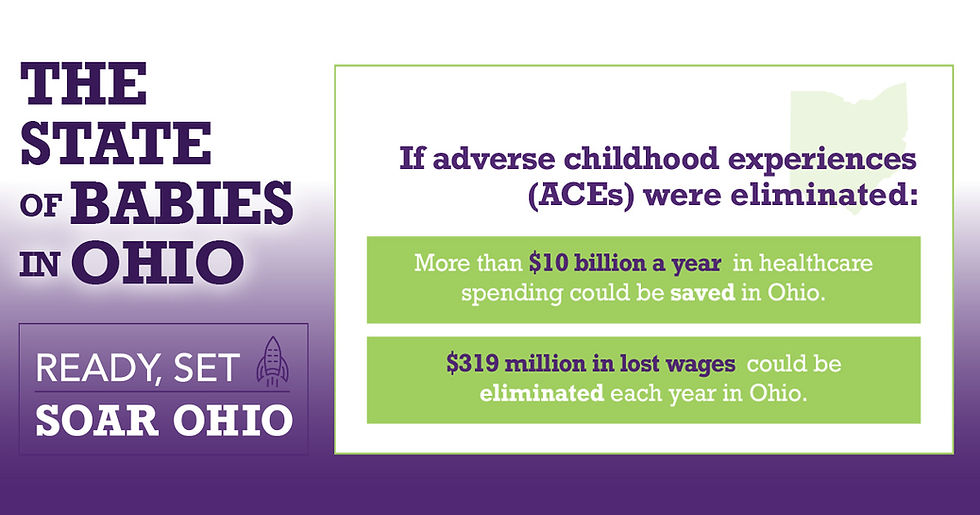The State of Ohio Babies in 2021
- jpeters461
- Apr 7, 2021
- 3 min read
The earliest years of a child’s life are the most critical, setting a foundation that will support them for the rest of their life. With more than 80 percent of brain development happening in the first three years of life, early experiences play an outsized role in shaping later learning, behavior, and health. Infants and toddlers who are born healthy, grow and develop in healthy environments, and have access to quality health care services have better physical, emotional, and mental health throughout their lives.
Unfortunately, not all babies get a strong start in life. All too often, a baby’s race, geography, and family’s income determine how they’ll do in life, including whether they experience poor health outcomes, child poverty, food insecurity, trauma, and other adverse childhood experiences (ACEs).
As a new factsheet from Ready, Set, Soar Ohio shows, Ohio infants and toddlers experience poor health outcomes and adverse childhood experiences at a higher rate than many other states. The factsheet – which features data analyzed and compiled by the Health Policy Institute of Ohio – should serve as an urgent call to local, state, and federal policymakers to support investment in pregnant women, infants, toddlers, and their families so that every child can grow and thrive.
Ohio ranks poorly on key indicators of early child health and well-being
As the Ready, Set, Soar Ohio factsheet illustrates, Ohio ranks poorly on key indicators of early child health and well-being. Compared to other states and the District of Columbia, Ohio ranks:
43rd in housing with a lead risk
42nd in infant mortality
39th in adverse childhood experiences (ACEs)
36th in child poverty
31st in low birth weight
28th in child abuse and neglect
If we are to build the way to a brighter, healthier future for all Ohio children, policymakers must do more to support our youngest children and their families.
Large racial and economic disparities exist across key indicators
Not only does Ohio rank poorly on key indicators of early child health and well-being, but there are distinct racial and economic disparities across these indicators. From infant mortality to child poverty to food insecurity and beyond, Ohio’s Black and Hispanic children are impacted at a disproportionately higher rate than white children in Ohio.
For instance, Black babies in Ohio are more than 2.5 times more likely die before their first birthday than white babies. Black and Hispanic families are far more likely to experience food insecurity than white families, while a family who earns less than 50% of the Federal Poverty Level is more than 13 times more likely to be food insecure than a family earning 400% of the Federal Poverty Level.
Young children who start behind often stay behind. To advance equity for all young children, Ohio must focus on closing gaps when they first appear in a child’s life.
Childhood adversity and trauma have long-term impacts
Adverse Childhood Experiences (ACEs) are traumatic events that have the potential to cause long-lasting negative effects on mental health, physical health, and behaviors. ACEs also have a multigenerational effect: the impact of a parent’s adverse experiences can influence their child’s development.
As the Ready, Set, Soar Ohio factsheet demonstrates, ACEs are costly: If ACEs were fully eliminated, Ohio would save more than $10 billion in health care spending. With Ohio ranking 39th in the nation for ACEs, it is critical that the state provide interventions for both parents and children to help struggling families create stable, nurturing environments that allow young children healthy physical and emotional development.
All babies are born with the ability to reach their highest potential, but all too often babies face barriers and circumstances that hold them back. There are many opportunities to promote healthy development, prevent trauma, and support at-risk babies in Ohio through a continuum of services that improve outcomes for babies. By investing in high-quality, evidence-based programs and services that support infants, toddlers, and their families, policymakers can make Ohio the best place to be a young child.
Share the factsheet and this story on social media using the hashtag #StateOfOhioBabies.








Comments